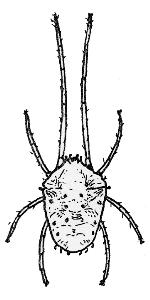| | One of the first pests to become evident in the spring is the clover mite, Bryobia praetiosa. This species of mite is smaller than a pinhead and is dark red, rusty brown or olive green. It has eight legs, of which the front legs are two to three times longer than the other legs and characteristically extend forward from the body.

Life History and Importance
During the spring and summer months, clover mites are active at temperatures between 4°C and 24°C, feeding on the sap of many trees, shrubs, flowers and grasses throughout Alberta. They rarely become a nuisance out-of-doors, except occasionally on lawns.
In the fall, particularly during November and December, these mites migrate from their dwindling food supplies, sometimes in enormous numbers, to lay small, red, overwintering eggs in cracks and crevices on trees and buildings. The eggs are produced without fertilization, as male clover mites have not been found.
Mites may be particularly heavy on the warmer, south-facing walls of buildings, and they may find their way indoors through cracks in walls and around doors and windows. Clover mites tend to be only a temporary nuisance.
Overwintering eggs laid in the fall begin to hatch the following April and May, earlier if the weather is favorable, and young mites in their search for suitable food plants once again invade houses.
Although short-lived and not harmful to people, pets or household articles, large numbers of mites are a nuisance and leave red stains when crushed. They are more likely to be a problem in areas of newly established gardens or lawns, where there is a dense growth of succulent, well fertilized grass close to foundation walls.
Control
The first line of defense against clover mites is to seal off their entry points into the house. Caulking may be used around windows and weather stripping around doors. Cracks in foundations and walls should be filled.
The second line of defense is to keep the grass very short around the foundation, or preferably, to replace it with a 0.6 m wide strip of bare soil, coarse sand or pea gravel (concrete is not as effective). Be sure to keep the area clean of trash, debris or vegetation that can serve as a bridge for the pest.
Mites can be temporarily removed from the outside of buildings by spraying down with water. Water treatments do not provide residual control. A more aggressive control method would be the use of an insecticide applied as a spray to the outside walls, foundations and ground in a4.5 to 6 m wide strip around the house. Be sure to read and follow the label recommendations before using an insecticide.
To deal with mites already in the house, carefully vacuum infested areas in the house to remove the mites without crushing them and leaving stains. A spot treatment of an insecticide registered for use indoors around windows, doors, baseboards and other entry points can be used.
Prepared by
Shelley Barkley
Alberta Agriculture and Rural Development
More information
Alberta Ag-Info Centre
Call toll-free 310-FARM (3276)
Source: Agdex 622-5. Revised March 2010. |
|